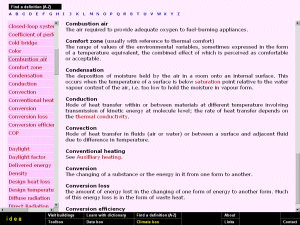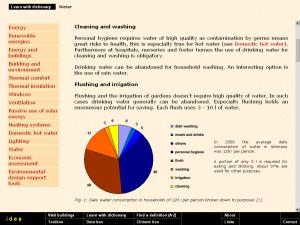IDEA
Interactive Database for Energy-efficient Architecture
The program part "encyclopaedia" includes two sections: A "glossary" compiles about 100 relevant key words which refer to the technical terms of building physics, solar energy application and energy technologies.
The section "key topics" is a collection of 15 chapters on important subjects, each summarizing the current state of the art and providing access to further reading by lists of references.
|

Encyclopaedia: Glossar
The glossary of IDEA comprises about 100 terms with short relevant definitions and explanations concerning energy and passive and low energy solar architecture.
|

Encyclopaedia: Key topics
Key subjects of energy-efficient and solar building are summarized in fifteen chapters providing both, an introductory survey as well as references for further reading.
|
IDEA is a collaborative project of several European universities and institutions with departments of architecture, civil engineering and building physics.
This structure of the IDEA consortium enabled a multidisciplinary and multimedial approach to energy-efficient building: A well prepared collection of building
examples together with calculation tools, databases and an encyclopaedia. There, main emphasis focuses on heating, as climates with less than three heating months have been excluded.
The IDEA software addresses professionals in architecture and civil engineering, students thereof as well as all institutions for energy consultancy and even interested layman.
You are interested in IDEA?
For the actual prices as well as information for ordering IDEA please refer to our product overwiev.
For further information on the project IDEA please contact:
Prof. Dr.-Ing. F.D. Heidt
Universität Siegen
Fb 7, Fachgebiet Bauphysik & Solarenergie
D-57068 Siegen
Germany
T: +49-271-740-3817
F: +49-271-740-3820
E: heidt@physik.uni-siegen.de
IDEA was funded by:

|
Fifth Framework Programme of the European Community (1998 - 2002)
|
The partners of the project are:
- Centre Universitaire d'Etude des Problèmes de l'Energie,
Université de Genève, Switzerland
- Centre Scientifique et Technique du Bâtiment,
Energy, Indoor Environment and Automation Department, Marne-la-Vallée, France
- Architectural Association Graduate School,
Environment & Energy Studies Programme, London, United Kingdom
- Architecture et Climat,
Université Catholique de Louvain, Louvain-la-Neuve, Belgium


